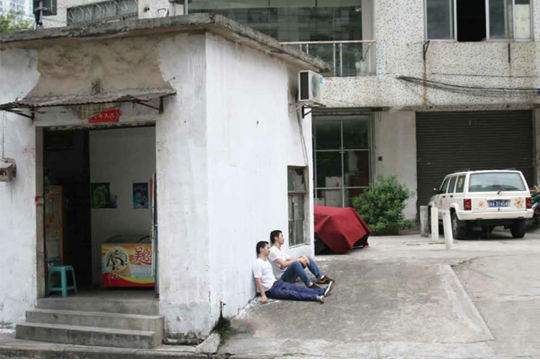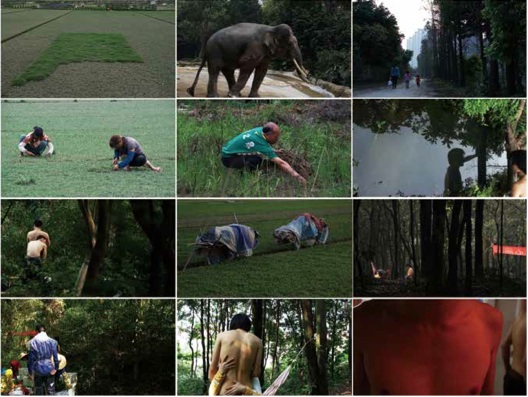ZHOU TAO: THE BODY AND ITS DEPTH OF FIELD
| May 22, 2013 | Post In LEAP 20

THE BODY, AS the most apparent symbol and object of all the various forms of conscious- ness and conceptual undertakings, along with the evolution of modern industrial society and contemporary consumerist culture, has itself become a prominent discursive object, which is continuously being redefined, rewritten, and disciplined. Of the artistic practices that correspond to or contradict this new discourse of the body, cinematography and filmic narrative have emerged and evolved to allow the unprecedented concretization of individual and public discourses about the body as it appears in different social situations. The reproduction of the world has gradually become an almost automatic mechanism. At the same time, images of us and others are pushed before our eyes as truth. Never have I observed myself so closely as when looking at these images. The body is no longer a fragile, temporary thing; the perception of the body is no longer an abstract moment that hits the artist like divine light. The moving image has transformed the body into a substance that exists independent of the flesh, giving it a kind of eternal existence.
In other words, bodily discourse combined with filmic narrative widens the rift between existential self-consciousness and human life as perceived through the body. Are life and coexistence no longer the body’s only fates? Have symbols of the body replaced the body’s self-practicing individual consciousness? And as discourse and knowledge of the body approach the infinite, is the self then gradually fading into the realm of nothingness? In one sense, when the body—representing various ideas and symbols—crosses into the artist’s creative vision, the artist must face such a reality: confronted with explosive bodily discourse and practices of the past, what new discourse can the body construct within the language of art? Or, perhaps the body does not need more discourse, instead simply to be a body and leap back into the unknown journey of life?

In Zhou Tao’s work since 2003, the body has emerged as the most important object, and the method through which Zhou expands his creative process, while moving images demonstrate his continued exploration of its condition and scope. In the video installation Wish You Make a Pile (2003), the body is an object of knowledge and analysis, with additional meaning and related materials as vehicles for social narrative. In Chicken Speak to Duck, Pig Speak to Dog (2005), One Day, Guangzhou (2007), and One Two Three Four (2007), the body is a metaphor for social discourse. As such, Zhou’s early works are also attempts of individual experimentation within the body’s social awareness and conceptual presentation. At the same time, he is careful in his usage of the conventions of social narrative that include existing body-symbol discourse and socio-conceptual contexts. In Chicken Speak to Duck, Pig Speak to Dog, for example, he does not deliberately high- light the differences between urban and rural, instead letting the entire scene proceed abstractedly in the space surrounding a tree. In One Two Three Four, other than the uniforms that some subjects wear, Zhou gives very little additional information about each person’s occupation or social status. In both works, framing and editing focus on showing bodily senses and physical movement. It can be said that Zhou is not convinced by artistic practice that treats the body as discourse. What the audience sees in his video work is the joy and pleasure of physical movement, which transcend the social symbols and discourse that cover the body. Zhou maintains a distance between his work and real-life situations, such that the viewer can build an even more abstract relationship with the objects therein, not to be easily swept into the collective imagination and interpretation expressed by contemporary art (e.g. socio- political criticism and symptoms of depression).
THE BODY AND ITS SPATIAL PERCEPTION
IN HIS PRACTICE from 2008 to 2009, Zhou Tao increasingly confirmed that he worked to explore a way of perceiving the body’s materiality and spatiality, toward which he began a series of tests and exercises. Tide (2008) is both an opportunity and the key to opening our dialogue with Zhou’s style of bodily practice. During a chance encounter with an abandoned space on Wailingding Island in Zhuhai, Zhou used his body to experience an entire course of the rising and falling tides. To the maximum extent possible, he extracts his body from social discursive space and suspends it singly within material objects. At the same time, material space, rhythmic substitute symbols, and discourse cover his body; the behavior thus loses its expressive space. Is this the artist’s interrogation of the limits of behavior, of ultimate meaning? In the images condensed into a fourteen-minute video, the body does not even appear as a symbol of the artist, but instead as a physical space through the actions of which we cannot construe mood or meaning. To the artist, as his body is flooded and touched by the world, all of the habitual experiences of his body, weight, and pain are pushed toward opportunities for new sensations and thoughts. What Zhou tries to show in this short film of a dozen minutes is not some concrete idea or attitude. The narrative and images set in motion by such an intuitive and physical reaction, are a reflection upon the working situation and narrative method of artists in mainstream conceptual art, video art, and other concept-driven art. The difference here is that rather than manufacture superficial melodrama and confrontations, the artist’s body maintains its calm and elegance in the material world. It is only by striving to maintain strength of consciousness throughout this process that the artist’s body does not drift away with the waves in a state of unconsciousness. After the tides have fallen, we discover that his hand is holding a soaking wet book, rendered unreadable.

In the works that followed, including Obstacle (2008), East Sixth Street (2009), and Time in New York (2009), Zhou, in an even more open way and more meticulous state of consciousness than before, conveys the points of contact and stratagems between the body’s sense of space and actual mate- rial space. Instead of controlling the body’s spaces towards realizing previously held beliefs, he borrows documentary film and editing methods to present the moments that have a determining value during the emergence of the body’s relationship with itself and its surroundings. Writing in his journal, Zhou attempts to record the moments when he becomes aware of this relationship: “gray wrinkles,” “volume of time,” “image event,” and so on. Compared to his more tranquil video work, this rapidly evolving vocabulary shows that the artist is not eager to search for a conceptual path, but intends to resolve conceptual obstacles through open-ended description.
THE BODY, VIDEO, AND TEMPORAL VOLUME
IN Mutual Exercise (2009), Zhou begins to try inviting other people’s bodies into the creative process. He and his roommate act out, on the street where they live, all of the activities and moments that could be happening in the nearby wholesale book warehouse. Sometimes they move each other’s body like objects, sometimes they pause, again just roommates. Rehearsed and spontaneous actions happen in parallel. For Zhou, another person’s body is different from the performers in Chicken Speak to Duck, Pig Speak to Dog, neither is it the observed subjects in One Two Three Four. It is closer to Robert Bresson’s description of the objects of his camera during the process of creating his films: “No actors…but the use of working models, taken from life.” Bresson views modeling as an activity that goes from the exterior to the interior, not from the interior to exterior like acting. If the collaboration between Zhou and his roommate in Mutual Exercise is an impromptu test, then the collaboration with Ah Yue, who is such a “model,” in South Stone (2010-2011) is an intentional test by the artist to combine bodily practice and imagery to construct a platform for perception. Together, Zhou and Ah Yue lived in South Stone village, along Guangzhou River, for nearly a year. The artist and model becoming each other’s medium and space, no longer consumed by the entanglement of separating “I” and self. “He” is the object of the artist’s transference (another equivalent body’s perception of space); “he” is also the shifting actual material space that accompanies the artist, who is continuously touching this space. The physical perception of boundary between the artist’s self and another is further eliminated in the images. Through the viewfinder on a camera, the artist’s vision grows more expansive. South Stone becomes a visual catalog about the body’s perceptions that extends beyond the artist’s self and physical narrative: the intertextuality between scenery and beings, nature and affect mix together to generate a path for the emergence of multiple narratives and meaning. Opening a freer sphere for the viewer’s relationship to the images, the audience basically can enter this work’s imaginative space from any point—the artist preserves his possibility of constructing self perception, even when faced with the powerfully linear logic of images. Zhou is attempting to convert video practice into a platform for exercises in self-perception, and not only as a creative medium or material. He does not favor making video and its attendant exhibition format and space as some visualized concept or conclusion, instead paying attention to—in today’s climate where image creation and exhibition grow more mechanized everyday—exploring possibility for openness in narrative mechanism and meaning generation, and preventing conceptualized language and scheme from becoming perceptional blocks to the artist’s examinations.
It is worth noting that, beginning with Collector (2012), Zhou Tao increasingly treats the image as a material form and actual space, leading to his physical perception and narrative experimentation. Behaviors that distinguish him as the artist are increasingly difficult to identify. Scenes of rehearsal between the artist and his model, improvisational behavior, and sequences that document reality are intermixed. Their actions toward reality itself—imitation, simulation of living systems—impromptu events and moments that occur in the world, become mutually supporting scenarios through the nonlinear arrangement of images. These actions and events, under the effect of mutual linkages and indications, flow out from the framework of recording, collect and become a “volume of time” that is not limited by the implications of social or material spaces.
After Reality (2013) is Zhou Tao’s newest work, completed during a residency at the Kadist Art Foundation in Paris. In the film, plants grow wildly according to their own instincts, surpassing all the rest of nature and manmade objects, occupying the maximum possible screen space and dominating the depth of field. Without a moment of hesitation, these plants frankly stationed themselves in all the possible remaining spaces, filling fields, rivers, water surface, in a stalemate with the concrete and metal components of elevated bridges and buildings. Heavy vegetation flourishes in the wet climate of southern China, and here it seems to be the only undisputed witness that lingers in the space between true and false intentions. In Zhou’s images, vegetation becomes the new object of transference—just as he had treated the body’s perceptions as the background for existence—for continued encounter with the world.


